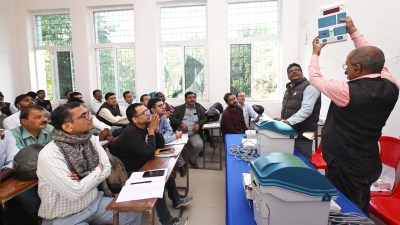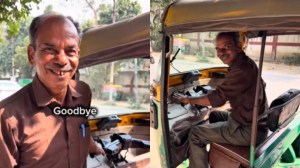Maharashtra now plans ‘Liberation from Nizam’ celebration—Marathwada Mukti Sangram Din
Year-long festivities rather than the usual low-key function in Aurangabad; comes a month after similar celebrations in Hyderabad
 CM Eknath Shinde has constituted a sub-committee of ministers from the region—known administratively as the Aurangabad division on Maharashtra's east, bordering Telangana—for monitoring and implementing the plans over next year. (Express File)
CM Eknath Shinde has constituted a sub-committee of ministers from the region—known administratively as the Aurangabad division on Maharashtra's east, bordering Telangana—for monitoring and implementing the plans over next year. (Express File)The Maharashtra government has announced year-long celebrations ahead of the 75th Marathwada Mukti Sangram on September 17, 2023 — the 75th anniversary of Marathwada’s liberation from the princely state of Hyderabad by the Indian Army. As a first step, Chief Minister Eknath Shinde has constituted a sub-committee of ministers from the region—known administratively as the Aurangabad division on Maharashtra’s east, bordering Telangana—for monitoring and implementing the plans over next year.
The minister for the Employment Guarantee Scheme, Sandipan Bhumre, health minister Tanaji Sawant, agriculture minister Abdul Sattar and minister for co-operatives Atul Save constitute the sub-committee, whose member secretary will be the region’s divisional commissioner. Initially, the sub-committee will chalk out programmes to schedule over the next year and work out budgetary requirements. The details and final approvals will be given by CM Shinde and Dy CM Fadnavis by month-end.
For seven decades, every ruling dispensation has marked the Marathwada Mukti Sangram Din with a low-key function in Aurangabad. No wonder eyebrows are being raised about the year-long bash being planned by the BJP-Balasahebanchi Shiv Sena combine. The question on everybody’s lips is if there is any political agenda, or if the current rulers are trying to capitalise on the diamond jubilee of the event to raise awareness about its significance.
Marathwada is the most backward and drought-prone region of Maharashtra, comprising eight districts—Aurangabad, Beed, Latur, Nanded, Hingoli, Jalna, Parbhani and Osmanabad. It is also the region that has given Maharashtra three chief ministers (all Congress)—Shankarrao Chavan, Vilasrao Deshmukh and Ashok Chavan.
Officials at the CMO revealed, “Marathwada Mukti Sangram is a historical milestone in India’s Independence. Unfortunately, it has never been glorified. As a result, the present generation is not even aware of the agitation and sacrifice we’ve made to liberate Marathwada from the erstwhile Nizam’s rule.”
In the run-up to its 75th anniversary, the state government has planned year-long celebrations to take the history to the masses, he also said, adding that the details are being worked out.
When, after Partition, princely states were given the option to choose between India and Pakistan, the Nizam of Hyderabad, Osman Ali Khan, chose to remain independent, filing an appeal with the United Nations, seeking his right for separate statehood. The Hyderabad State under the Nizam’s rule included Marathwada and parts of Telangana.
People of Marathwada, who wanted to become part of Independent India, revolted under the leadership of prominent social thinkers and reformers like Swami Ramanand Tirtha, Govindbhai Shroff, P.H. Patwardhan, Vijayendra Kabri and Ramanbhai Parikh. Early in the agitation, one Bahiri Shinde was killed by the Nizam’s forces at Aajegaon, sparking revolt across the rural areas.
It also provided the casus belli for the nascent Indian State to launch military action, called Operation Polo, to annex Hyderabad. With the princely state annexed, the Marathwada region was added to Maharashtra.
Taking a cue from the Centre—which keeps highlighting favourable historical events to reach out to the masses in the name of creating awareness—the state government has embarked on its own year-long plan. All state ministers, MLAs and MPs will be entrusted with the task of holding public gatherings in their constituencies to impress upon the people the importance of the event.
A senior BJP functionary said, “Politics is about connectivity and communication. The BJP believes when you have such a historical event, its celebration helps uniting people across community, caste and religion,” adding, “This will provide the party a good platform to reach out to the maximum number of people.”
Apart from celebrations, the BJP and the Shinde Sena also want to consolidate their political base in the region. Marathwada has eight Lok Sabha seats (out of Maharashtra’s 48) and 48 assembly seats (out of 288 in the state).
Emotive and sensitive issues, like renaming of Aurangabad city as Sambhajinagar (after Sambhaji Raje, son of Chhatrapati Shivaji Maharaj) has already made this a volatile political pitch. The proposal was passed in the state cabinet, but the tussle for one-upmanship on renaming remains a bone of contention between BJP and Uddhav Thackeray’s Shiv Sena faction, with the Shinde Sena also hoping to encash the issue.
The BJP already made its intentions clear, when it raised a ruckus at Hyderabad on September 17 this year, celebrating it as Hyderabad Liberation Day and accusing previous dispensations of not highlighting its importance thus far due to vote-bank politics. It raised the hackles of Telangana’s ruling Bharat Rashtra Samithi (then called Telangana Rashtra Samithi or TRS), which insisted the occasion be called Telangana Unity Day.
As part of the celebrations, the state government has also decided to draw up a comprehensive plan for the holistic development of Marathwada, with focus on making the region drought-free.
In 2016, then CM Fadnavis had convened a special cabinet meeting at Aurangabad and announced a Rs 49,248 crore package for the region’s development, with emphasis on irrigation and infrastructure projects. Of these, a water-grid project—to take water to every household—remaining unaccomplished.
A minister in the new sub-committee, on condition of anonymity, said, “When we hold programmes, we can’t talk of history alone. People would like to know what we have to offer them, to make their lives and livelihoods sustainable in the liberated Marathwada. So, whether it is farmers, women, youths or industries, we have to provide them with solutions and a secure future.”
The Shinde and Fadnavis government believes it can strive to give Marathwada a much-needed makeover through their year-long campaign.
In 2016, following three consecutive years of drought, the Centre was forced to send a train-load of drinking water to supply Latur city and rural areas. Subsequently, the drinking water crisis was addressed to some extent through the state government’s Jalyukt-Shivar Abhiyan. With the Shinde-Fadnavis government having 2.5 years of its tenure left, it believes it can once again aggressively project this scheme.
Earlier this week, Fadnavis said, “Drought-free Marathwada and Maharashtra is our commitment. Through Jalyukt-Shivar, we will once again ensure that each and every village across Marathwada is not only drought-free, but also water reliant and water surplus.”



- 01
- 02
- 03
- 04
- 05




























